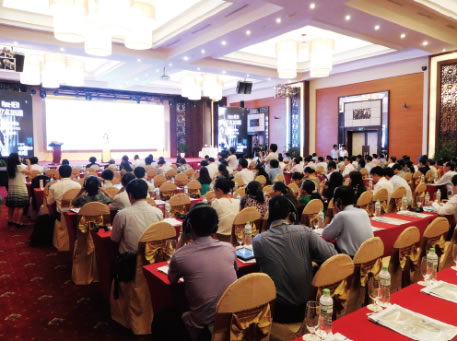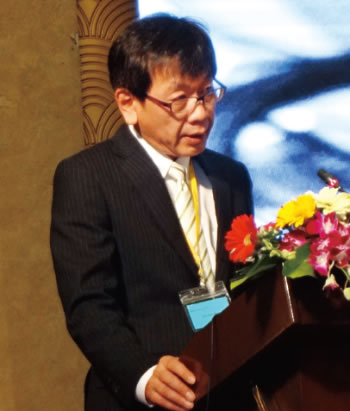Master Techniques from Japan to the World 2
Sharing Medical Information
with Patients through
Mame-NET
– Utilizing IT to improve medical services in Viet Nam

The Mame-NET seminar held in the Nghe An Province, Viet Nam (Photo: Techno Project Japan Co., Ltd.)
With assistance from countries around the world, Viet Nam is enhancing its medical facilities. However, improvements have come to a halt at individual medical institutions and facilities, and this has created significant regional disparities in medical care standards. Patients, therefore, tend to go to major hospitals in urban areas, causing chronic overcrowding at these institutions. Major challenges facing Viet Nam are therefore, to alleviate this overcrowding issue and to improve medical service standards in rural clinics.
Techno Project Japan Co., Ltd. (TPJ), a software development company based in Matsue City, Shimane Prefecture fixed their eyes upon against the status of medical services in Viet Nam. TPJ thought that Mame-NET, a network system TPJ had developed for exchanging medical information among regions, could be useful in Vietnam. Further impetus was provided by the fact that one of TPJ’s engineers had previously worked in the IT industry in Viet Nam. Through this fact, the company realized that social issues being experienced in Viet Nam, such as the disparity in medical services between rural and urban areas, were similar to those in Shimane Prefecture. In order to seek to spread Mame-NET throughout Viet Nam, from February 2015 TPJ launched a Verification Survey1 under JICA’s Partnership with Japanese SMEs for the Private Sector for Utilizing Japanese Technologies in ODA Project2 in Vinh City, the capital of Nghe An Province.
The system was named “Mame-Net” after the Shimane dialect in which “Mame” means “vigorous”. In Shimane Prefecture the aging population keeps increasing its demands on health and medical services, but due to issues such as doctor shortages, it is getting difficult to maintain the necessary health and medical service structures. With the aim of achieving the provision of better medical services, Shimane Prefecture adopted Mame-NET, with the patient’s consent, this provides a mechanism for sharing the patient’s medical records, including examination record and medical history (collectively referred to as linked Electronic Medical Records (EMR)) among multiple institutions in various regions. These include core hospitals, clinics, inspection agencies and pharmacies. Utilizing EMR mainly, making good use of various functions of Image Diagnosis and so on, and sharing a patient’s medical information with multiple medical institutions could lead to the provision of safe and secure medical services, including accurate diagnosis, treatment and medication. Currently 770 medical institutions in Shimane Prefecture are participating in Mame-NET, with 30,000 patients registered in this system.

Mr. Masuo Fukada explains Mame-NET at the Nghe An Province medical IT seminar. (Photo: Techno Project Japan Co., Ltd.)
Using a specially improved version of Mame-NET that can be used in Viet Nam, TPJ is linking 3 hospitals and 25 community health centers (clinics) in the provincial city of Vinh, providing such services as review of individual patient’s medical information, issuance of referral letters to higher ranked medical institutions, linkage of EMR, and offering a message board. In addition, TPJ is working together with a leading medical systems company in Viet Nam to establish system operation training and a supporting structure for local doctors and staffs, and has also formulated a set of guidelines relating to use of medical information services.
Mr. Masuo Fukada, chief operations of TPJ, has this to say when he looks back at the time when the project was just being introduced, “In the beginning, the people in Viet Nam, who had grown accustomed to receiving overseas aid, did not show any particular interest. However, as we tried to listen to people in Viet Nam and repeatedly attempted proposals based on our understanding of their needs and the background for those needs, ,eventually, we also received opinions from local doctors and medical service employees. That was the moment I felt that we had successfully conveyed our aspiration and concepts, to solve social subject of Viet Nam.
The system has also brought about changes in medical care itself. For example, before the system was introduced, only fragmentary patient information was available in the form of paper-based referral letters. However, following the system’s introduction and the sharing of linked EMRs, it is now possible to confirm a patient’s entire medical history, which has also led to improvements in the quality of medical care. It has also been reported that the reduction of phone call conversations and paperwork has increased time available for responding to patients and this increased interaction has also boosted the motivation of medical staffs.
The aforementioned Mr. Fukada says, “In Viet Nam there is a tendency to respond by putting more human power on the job, even if it is apparently inefficient. The introduction of the Mame-NET system has made people working in medical services realize the advantages of utilizing IT to share information among medical practitioners on the job and it has also resulted in reductions in the time and costs required for medical care, as well as enhancing the quality of care standards. What is more, skills could be shared among medical staff and I believe it will be possible to improve medical services overall.” Following the conclusion of the Verification Survey in September 2016, the Department of Health of Nghe An Province is planning to keep Mame-NET up and running in the hospitals and clinics of Vinh city.
Mr. Fukada is looking forward to further expanding the project and says, “I hope that this project will provide an example of good practices for regional medical networks in Viet Nam. In the future I hope that the system will also incorporate nursing care services and grow to link not just Nghe An Province, but the whole of Viet Nam.”
A high quality medical system is now starting to take root in Viet Nam, powered by Japanese network technologies.
*1 A survey to verify ways to enhance a product or technology’s compatibility with a developing country and thereby disseminate the product and technology, based on a proposal from an SME.
*2 Projects aiming to achieve both the development of developing countries and the activation of the Japanese economy by utilizing Japanese SMEs’ excellent products and technologies through ODA.
<< Previous Page Next Page >>
Main Text | Statistics and Reference Materials | Stories from the Field | Master Techniques from Japan to the World | ODA Topics
